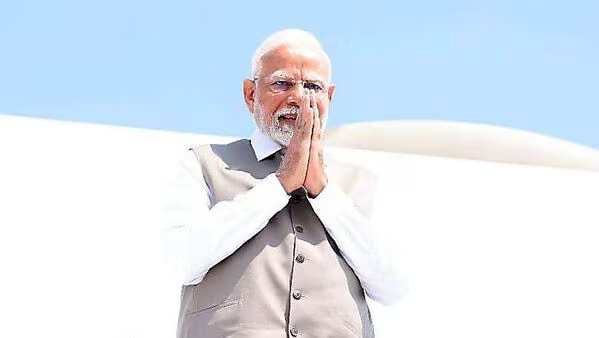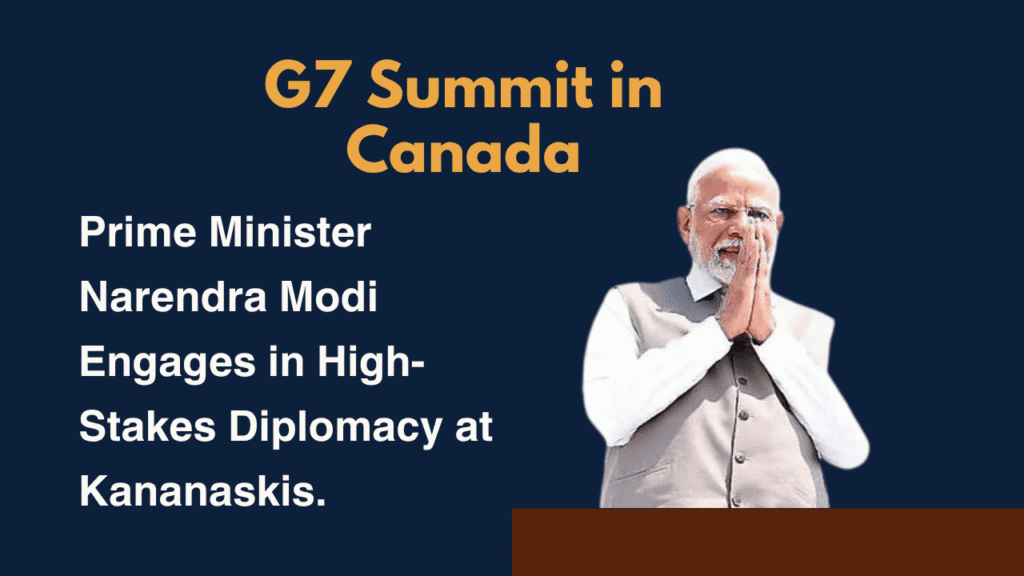Navigating Tensions and Trade at the 2025 Summit.
By Farru Tech News | June 17, 2025 | Kananaskis, Alberta
Table of Contents
G7 Summit in Canada
Prime Minister Narendra Modi’s arrival in the serene mountain town of Kananaskis, Alberta, on June 16, 2025, was anything but quiet in its implications. Landing in Canada as part of a whirlwind three-nation tour—spanning Cyprus, Canada, and Croatia—Modi stepped into a high-stakes diplomatic arena at the G7 Summit. Hosted by Canadian Prime Minister Mark Carney, this gathering of global leaders is a chance for India to flex its geopolitical muscle and for Modi to tackle the thorny issue of India-Canada relations. With trade, uranium deals, and global challenges like artificial intelligence and energy security on the table, the visit is a delicate dance of opportunity and caution. Here’s a deep dive into what’s unfolding in the Rockies.

A Summit with Global Stakes
The G7 Stage and India’s Role
The Group of Seven—comprising Canada, France, Germany, Italy, Japan, the United States, the United Kingdom, and the European Union—is a club of advanced economies shaping global policy. India, though not a member, has been a regular guest since 2019, a testament to its status as the world’s most populous nation and fourth-largest economy. Modi’s presence at the Kananaskis Summit, held from June 16 to 17, underscores India’s growing influence in areas like supply chains, technology, and energy markets. Canadian host Mark Carney, a former Bank of England governor who took office in March 2025, emphasized India’s centrality to discussions on energy security, the AI-energy nexus, and quantum technology.
Modi, fresh off India’s Operation Sindoor—precision strikes on Pakistani terror camps following the April 22, 2025, Pahalgam attack that killed 26 tourists—arrived with a clear agenda. In a departure statement from Delhi on June 15, he vowed to champion the Global South’s priorities, bringing the concerns of developing nations to a forum often dominated by Western interests. The summit’s agenda includes climate finance, supply chain resilience, and counterterrorism, areas where India seeks to lead. Modi’s meetings with leaders like U.S. President Donald Trump, French President Emmanuel Macron, and Japanese Prime Minister Shigeru Ishiba will shape these discussions, but his bilateral talks with Carney steal the spotlight.
The India-Canada Conundrum
A Relationship on Thin Ice
India-Canada ties have been a diplomatic rollercoaster, particularly since 2023, when Canada accused Indian agents of orchestrating the assassination of Hardeep Singh Nijjar, a Sikh activist and Canadian citizen, outside a Surrey gurdwara. The allegations, dismissed by India as “baseless” and “absurd,” triggered a cascade of retaliatory moves: diplomat expulsions, frozen trade talks, and suspended high-level visits by October 2024. India countered that Canada harbors Khalistani extremists, pointing to vandalism of Indian consulates and threats against diplomats. The rift, deepened under former Canadian Prime Minister Justin Trudeau, painted a grim picture of two democracies at odds.
Carney’s rise to power has shifted the mood. A political newcomer who campaigned on rebuilding ties with India, Carney extended a personal invitation to Modi on June 5, 2025, a move that raised eyebrows given the recent tensions. Modi’s swift acceptance and public congratulations for Carney’s election victory signaled mutual intent to turn the page. Ministry of External Affairs spokesperson Randhir Jaiswal called the visit a chance to “reset” relations, rooted in shared democratic values, mutual respect, and sensitivity to each other’s concerns. Yet, the Nijjar investigation and the Khalistan issue loom large, threatening to derail progress.
The Nijjar Shadow and Khalistan Tensions
The unresolved Nijjar case is a diplomatic landmine. Canada’s Royal Canadian Mounted Police have linked Indian officials to the killing, alleging “highest-level” involvement, though no evidence directly implicates Modi. Four Indian nationals face charges, with trials ongoing, and a U.S. indictment on a similar plot against a Sikh activist adds fuel to Canada’s claims. India, denying involvement, accuses Canada of sheltering Khalistani separatists, a movement banned in India for its violent history, including the 1985 Air India bombing that killed 329 people. New Delhi points to pro-Khalistan rallies and referendums by groups like Sikhs for Justice as threats to its security.
Canada’s 770,000-strong Sikh community, the largest Sikh diaspora globally, includes a vocal minority advocating for Khalistan, a separate Sikh homeland. India views this as a national security issue, demanding Ottawa curb separatist activities. Canada, citing free speech protections, has resisted, creating friction. Carney’s agreement to a “law enforcement dialogue” with Modi offers a potential bridge, addressing India’s concerns about extremism and Canada’s allegations of interference. However, protests by Sikh groups, including the World Sikh Organization, are planned during Modi’s visit, with some calling the invitation a “betrayal” of justice for Nijjar.
Economic Ambitions and Uranium Dreams
Trade: Untapped Potential
Economic ties are a bright spot amid the diplomatic gloom. In 2024, bilateral trade reached $8.6 billion, a modest figure given the potential. Canadian pension funds have invested $55 billion in Indian markets, and nearly 2 million Canadians of Indian descent—5% of the population—form a vibrant cultural link. Canada hosts over 400,000 Indian students annually, making it a top education destination alongside the U.S. The 6th India-Canada Ministerial Dialogue on Trade and Investment, held in Ottawa in May 2023, aimed to deepen ties, but progress stalled amid the Nijjar fallout. Modi and Carney’s talks seek to revive negotiations, potentially paving the way for a Comprehensive Economic Partnership Agreement.
Uranium: Powering India’s Future
A particularly tantalizing prospect is the renewal of uranium supply agreements. During Modi’s 2015 visit to Canada, the two nations signed a $350 million deal for Cameco Corporation, the world’s largest publicly traded uranium company, to supply 7 million pounds of uranium concentrate for India’s nuclear reactors. Reports suggest Cameco, based in Saskatoon, is eager to extend this partnership, aligning with India’s ambitious clean energy goals to achieve net-zero emissions by 2070. India’s Department of Atomic Energy sees Canada’s vast uranium reserves as a stable source amid global supply uncertainties. Discussions may also explore nuclear technology collaboration, building on the 2010 civil nuclear agreement.
Geopolitical Maneuvers
G7 Summit in Canada : India’s Global South Advocacy
Modi’s G7 agenda extends beyond Canada. His push to amplify the Global South’s voice resonates with developing nations grappling with climate change, debt, and trade inequities. India’s recent clashes with Pakistan, blamed for the Pahalgam attack, give Modi a platform to rally G7 support against cross-border terrorism. The absence of China and Pakistan from the summit allows India to frame its security concerns unopposed, a strategic edge noted by former Indian high commissioner Ajay Bisaria. Modi’s meetings with G7 leaders will also cover supply chain resilience, critical minerals, and digital transition, areas where India seeks partnerships.
G7 Summit in Canada : Carney’s Balancing Act
For Carney, hosting Modi is a domestic and international tightrope. His Liberal Party faces criticism from Sikh MPs like Sukh Dhaliwal, who argue the invitation overlooks the Nijjar case. Conservative Leader Pierre Poilievre’s support for the visit offers bipartisan cover, but planned protests risk diplomatic embarrassment. Carney’s emphasis on diversifying Canada’s trade partners and engaging democracies like India aligns with his economic vision, but he must navigate Sikh community sensitivities and uphold Canada’s stance on the rule of law. His call with Modi on June 5 was a calculated step, reflecting a desire to rebuild ties without compromising on the Nijjar investigation.
G7 Summit in Canada : Voices from the Ground
Public sentiment, captured on platforms like X, reveals a polarized landscape. Indian users hail Modi’s invitation as a diplomatic coup, crediting India’s global stature for forcing Canada’s hand. Posts from @SinghPramod2784 and @MeghUpdates frame it as a win for Modi’s leadership. Canadian voices are split: some welcome the economic potential, while others, like @AbhishBanerj, question Carney’s motives. Indian analysts like Meera Shankar see the visit as a starting point for reconciliation, while Canadian experts like David Mckinnon caution that normalization hinges on resolving the Nijjar and Khalistan disputes.
The human stories behind the diplomacy add depth. Canada’s 1.8 million Indian diaspora, including 1 million non-resident students and workers, are a bridge between nations. Sikh Canadians, many of whom cherish their dual identities, find themselves caught in the crossfire of political rhetoric. Families like that of Ujjal Dosanjh, a former Canadian minister of Indian descent, embody the shared history—marked by tragedy like the Air India bombing—that both nations must navigate.
What Lies Ahead
Modi’s time in Kananaskis is a fleeting but critical window. His meeting with Carney could yield symbolic gestures—reinstating diplomats, resuming trade talks, or signing a uranium deal—but deeper issues like the Nijjar case require sustained, discreet negotiations. The law enforcement dialogue is a promising step, but its success depends on both sides’ willingness to compromise. Protests and domestic pressures in Canada add complexity, while India’s focus on Pakistan and global challenges may dilute bilateral focus.
The Rockies’ calm belies the stakes. Modi and Carney, two leaders with crisis-management credentials, have a chance to rewrite a strained narrative. Whether they find common ground on trade, security, or mutual respect, their talks will ripple far beyond Alberta, shaping how two vibrant democracies coexist in a turbulent world.
Disclaimer: This analysis is based on publicly available information and is intended solely for informational purposes.
Source: News reports and official statements, June 2025.
